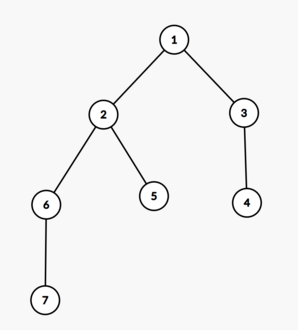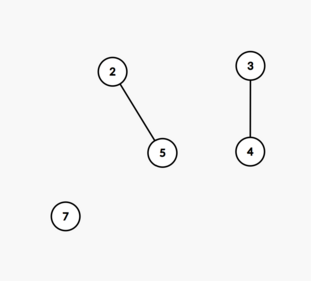310884: CF1904E. Tree Queries
Description
Since Hayate didn't get any Christmas presents from Santa, he is instead left solving a tree query problem.
Hayate has a tree with $n$ nodes.
Hayate now wants you to answer $q$ queries. Each query consists of a node $x$ and $k$ other additional nodes $a_1,a_2,\ldots,a_k$. These $k+1$ nodes are guaranteed to be all distinct.
For each query, you must find the length of the longest simple path starting at node $x^\dagger$ after removing nodes $a_1,a_2,\ldots,a_k$ along with all edges connected to at least one of nodes $a_1,a_2,\ldots,a_k$.
$^\dagger$ A simple path of length $k$ starting at node $x$ is a sequence of distinct nodes $x=u_0,u_1,\ldots,u_k$ such that there exists a edge between nodes $u_{i-1}$ and $u_i$ for all $1 \leq i \leq k$.
InputThe first line contains two integers $n$ and $q$ ($1 \le n, q \le 2 \cdot 10^5$) — the number of nodes of the tree and the number of queries.
The following $n - 1$ lines contain two integers $u$ and $v$ ($1 \le u, v \le n$, $u \ne v$) — denoting an edge between nodes $u$ and $v$. It is guaranteed that the given edges form a tree.
The following $q$ lines describe the queries. Each line contains the integers $x$, $k$ and $a_1,a_2,\ldots,a_k$ ($1 \leq x \leq n$, $0 \leq k < n$, $1 \leq a_i \leq n$) — the starting node, the number of removed nodes and the removed nodes.
It is guaranteed that for each query, $x,a_1,a_2,\ldots,a_k$ are all distinct.
It is guaranteed that the sum of $k$ over all queries will not exceed $2 \cdot 10^5$.
OutputFor each query, output a single integer denoting the answer for that query.
ExamplesInput7 7 1 2 1 3 3 4 2 5 2 6 6 7 2 0 2 1 1 2 2 1 6 3 1 4 3 1 1 5 0 5 2 1 6Output
3 2 1 4 1 4 1Input
4 4 1 2 1 3 2 4 2 1 3 3 1 4 2 1 4 2 3 1 3 4Output
1 2 2 0Note
In the first example, the tree is as follows:

In the first query, no nodes are missing. The longest simple path starting from node $2$ is $2 \to 1 \to 3 \to 4$. Thus, the answer is $3$.
In the third query, nodes $1$ and $6$ are missing and the tree is shown below. The longest simple path starting from node $2$ is $2 \to 5$. Thus, the answer is $1$.

Output
Hayate有一棵有n个节点的树。他想要你回答q个查询。每个查询包含一个节点x和k个其他额外节点a_1, a_2, ..., a_k。这k+1个节点保证都是不同的。对于每个查询,你必须找到在移除节点a_1, a_2, ..., a_k以及所有至少连接到一个节点a_1, a_2, ..., a_k的边之后,从节点x^†开始的最长简单路径的长度。† 一个从节点x开始的长度为k的简单路径是一个不同的节点序列x=u_0, u_1, ..., u_k,使得对于所有1≤i≤k,节点u_{i-1}和u_i之间存在一条边。
输入输出数据格式:
输入:
第一行包含两个整数n和q(1≤n, q≤2*10^5)——树的节点数和查询数。
接下来的n-1行包含两个整数u和v(1≤u, v≤n,u≠v)——表示节点u和v之间的边。保证给定的边构成一棵树。
接下来的q行描述查询。每行包含整数x,k和a_1, a_2, ..., a_k(1≤x≤n,0≤k
保证所有查询的k之和不超过2*10^5。
输出:
对于每个查询,输出一个整数,表示该查询的答案。题目大意: Hayate有一棵有n个节点的树。他想要你回答q个查询。每个查询包含一个节点x和k个其他额外节点a_1, a_2, ..., a_k。这k+1个节点保证都是不同的。对于每个查询,你必须找到在移除节点a_1, a_2, ..., a_k以及所有至少连接到一个节点a_1, a_2, ..., a_k的边之后,从节点x^†开始的最长简单路径的长度。† 一个从节点x开始的长度为k的简单路径是一个不同的节点序列x=u_0, u_1, ..., u_k,使得对于所有1≤i≤k,节点u_{i-1}和u_i之间存在一条边。 输入输出数据格式: 输入: 第一行包含两个整数n和q(1≤n, q≤2*10^5)——树的节点数和查询数。 接下来的n-1行包含两个整数u和v(1≤u, v≤n,u≠v)——表示节点u和v之间的边。保证给定的边构成一棵树。 接下来的q行描述查询。每行包含整数x,k和a_1, a_2, ..., a_k(1≤x≤n,0≤k